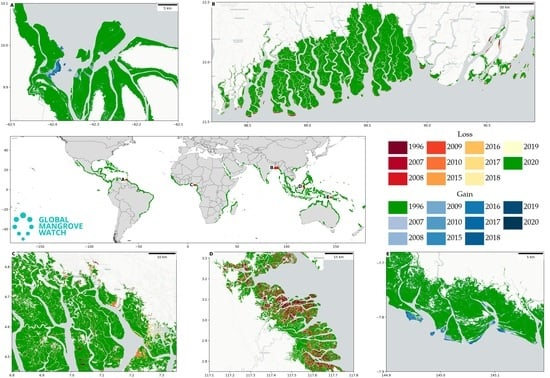Global Mangrove Extent Change 1996–2020: Global Mangrove Watch Version 3.0
Abstract
Share and Cite
Bunting, P.; Rosenqvist, A.; Hilarides, L.; Lucas, R.M.; Thomas, N.; Tadono, T.; Worthington, T.A.; Spalding, M.; Murray, N.J.; Rebelo, L.-M. Global Mangrove Extent Change 1996–2020: Global Mangrove Watch Version 3.0. Remote Sens. 2022, 14, 3657. https://doi.org/10.3390/rs14153657
Bunting P, Rosenqvist A, Hilarides L, Lucas RM, Thomas N, Tadono T, Worthington TA, Spalding M, Murray NJ, Rebelo L-M. Global Mangrove Extent Change 1996–2020: Global Mangrove Watch Version 3.0. Remote Sensing. 2022; 14(15):3657. https://doi.org/10.3390/rs14153657
Chicago/Turabian StyleBunting, Pete, Ake Rosenqvist, Lammert Hilarides, Richard M. Lucas, Nathan Thomas, Takeo Tadono, Thomas A. Worthington, Mark Spalding, Nicholas J. Murray, and Lisa-Maria Rebelo. 2022. "Global Mangrove Extent Change 1996–2020: Global Mangrove Watch Version 3.0" Remote Sensing 14, no. 15: 3657. https://doi.org/10.3390/rs14153657
APA StyleBunting, P., Rosenqvist, A., Hilarides, L., Lucas, R. M., Thomas, N., Tadono, T., Worthington, T. A., Spalding, M., Murray, N. J., & Rebelo, L.-M. (2022). Global Mangrove Extent Change 1996–2020: Global Mangrove Watch Version 3.0. Remote Sensing, 14(15), 3657. https://doi.org/10.3390/rs14153657










